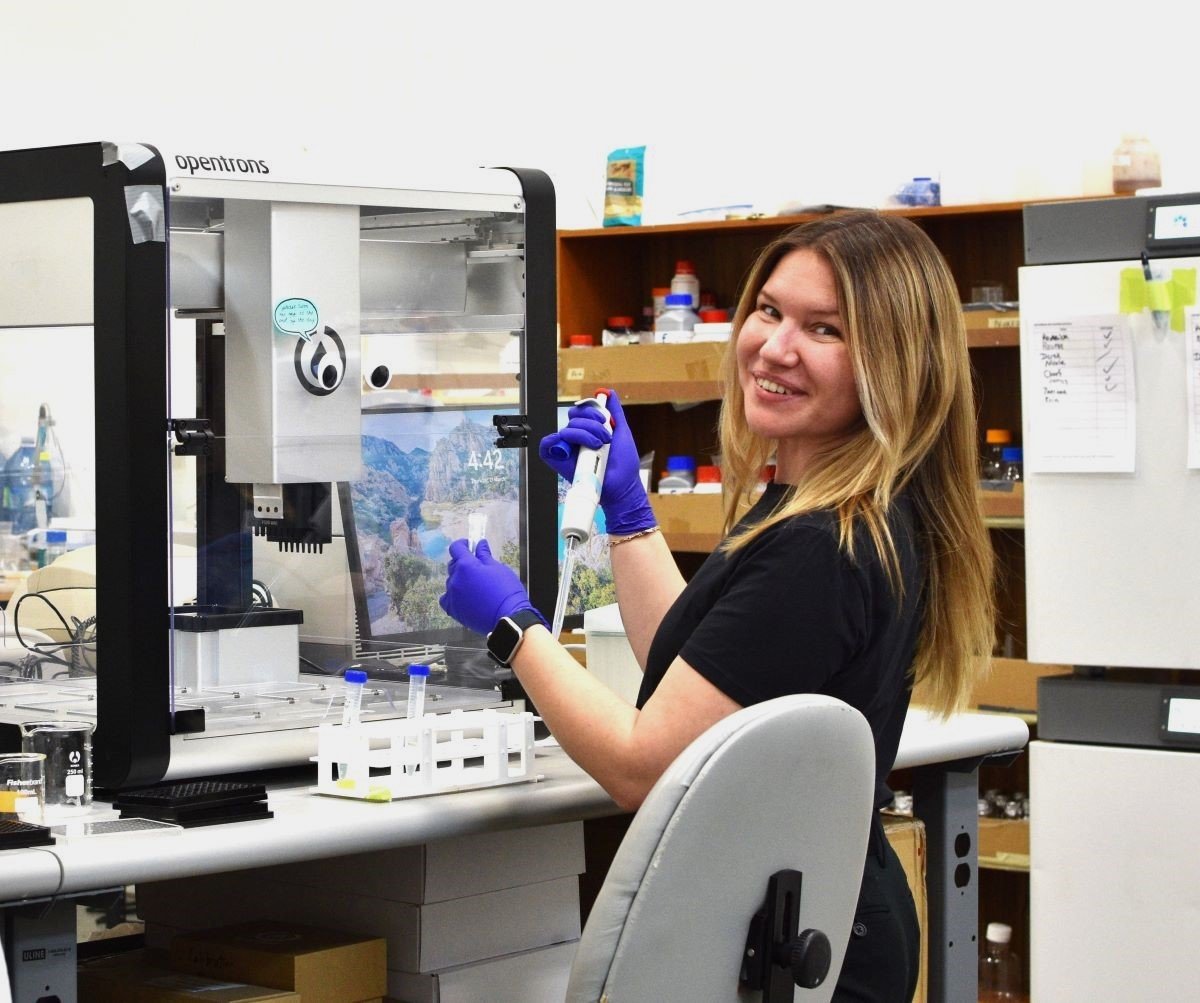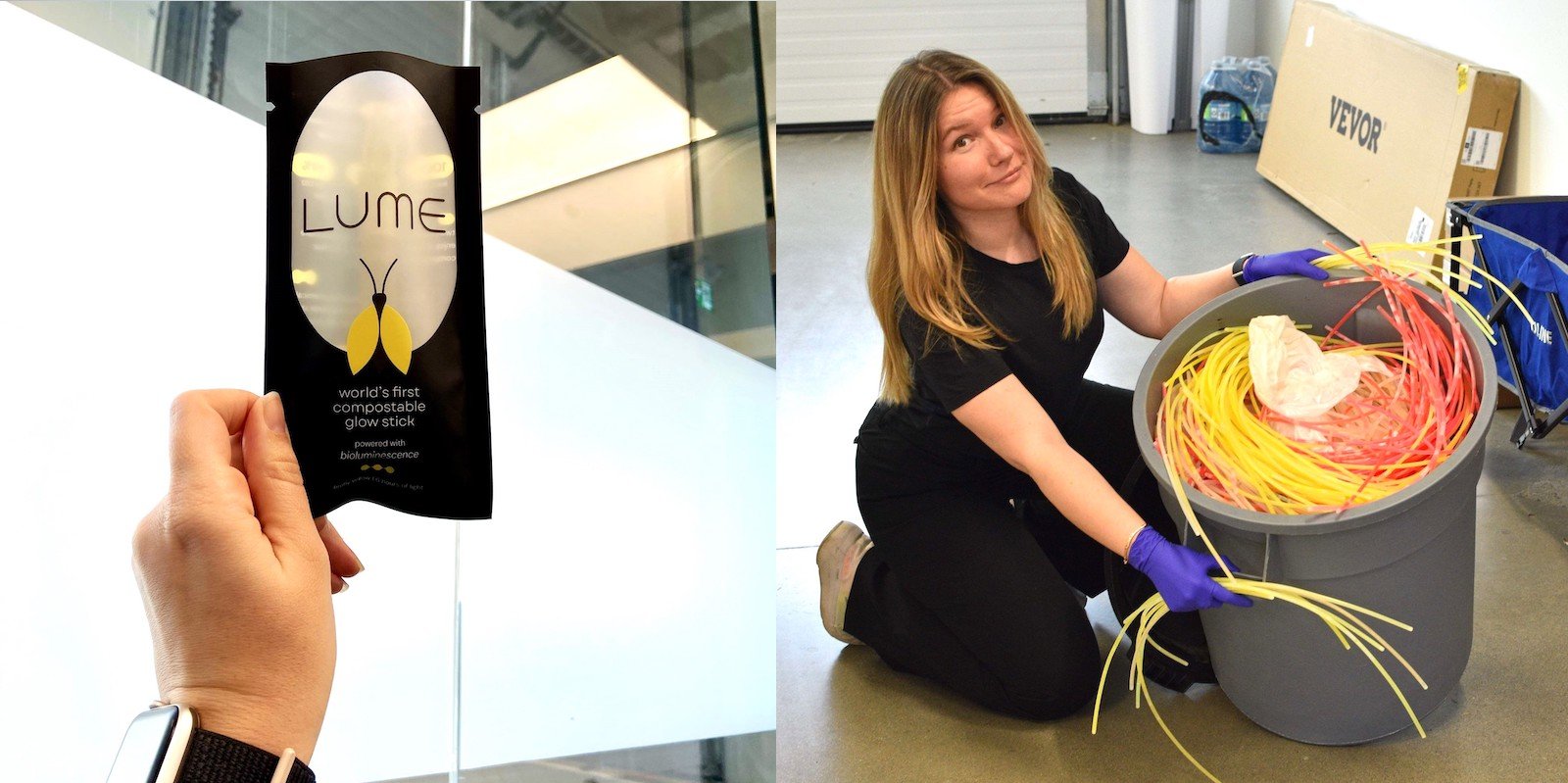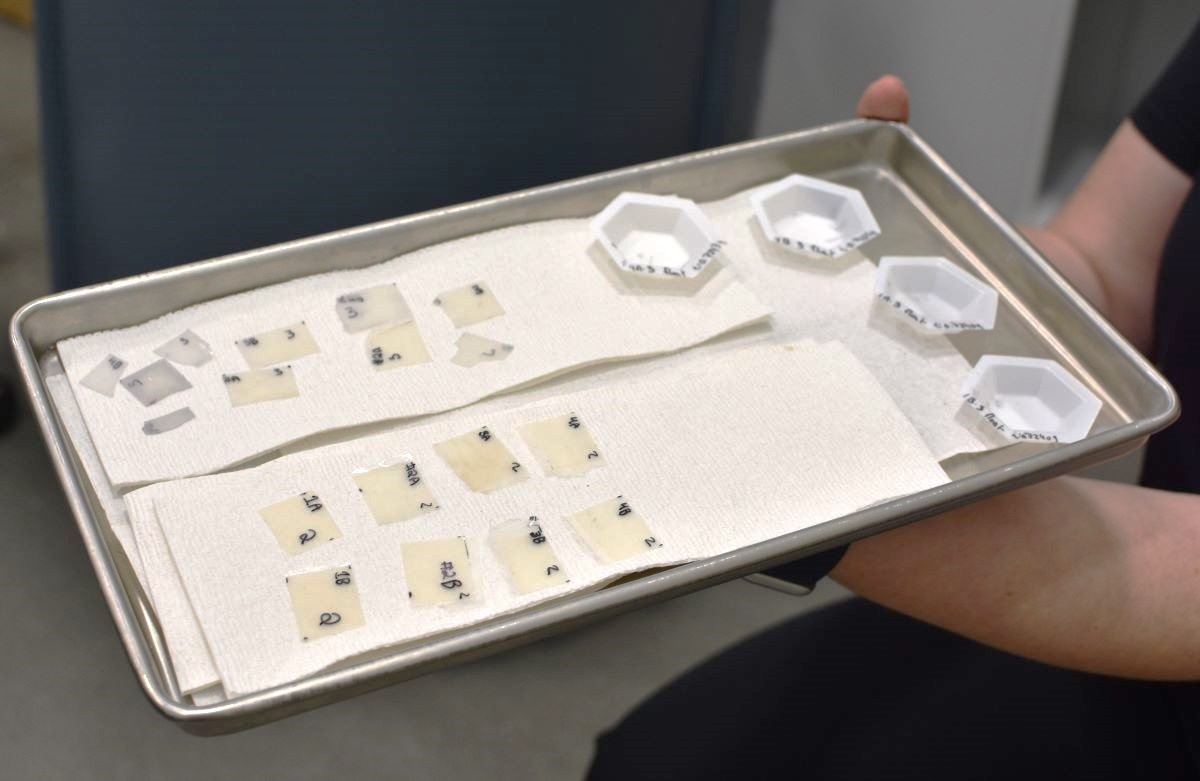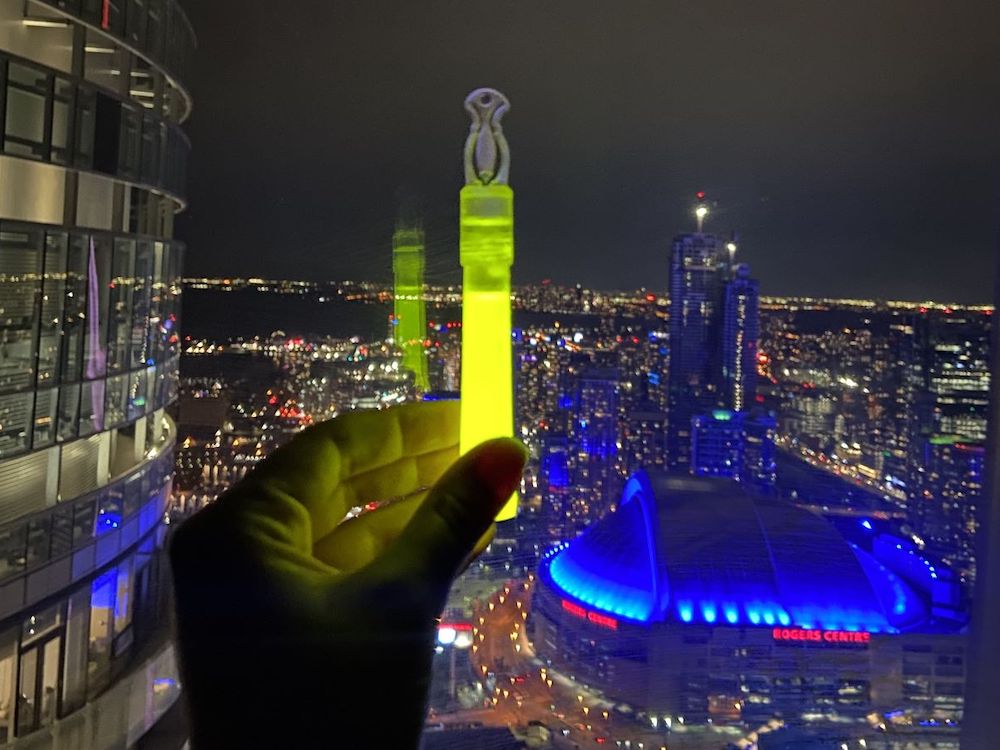Carrying around the world’s first compostable glow stick is sort of like keeping a jellyfish in your pocket.
And it solves a big problem that comes with the allure of traditional chemiluminescent glow sticks. For users who range from kids to soldiers to blissed-out music festival attendees, after about 12 hours the neon wand becomes useless trash, chemically contaminated and non-recyclable.
Ten years ago, Paige Whitehead saw that downside first-hand while volunteering to pick up garbage at the Shambhala Music Festival. Today she is CEO of a Vancouver startup called Lux Bio that’s releasing its own version of the iconic bendy light — powered by bioluminescence and completely biodegradable.
“I never thought I’d be running a company. It was never my goal,” she said. “But I’ve always been a problem solver and this is a way you can solve a problem.”
In June, Lux Bio will send out its first official orders of its new glow stick. Called Lume, it features a biodegradable casing and an enzyme-based light that’s designed to glow for around six hours.
Steven Hallam, a professor in the University of British Columbia’s department of microbiology and immunology, said Lux Bio’s ability to recreate a natural cellular process is impressive.
“Lux figured out how to make that light without all the complexity. They simplified the process, and they can do it in a test tube,” he said. “And because they can do it with biological materials, they can circumvent the petrochemical process that’s currently used for producing things like glow sticks.”
The market for Whitehead’s innovation extends far beyond birthday parties for tweens.
Originally produced in bulk for the American military, the little lights have broad appeal because they are portable, waterproof, non-flammable and inexpensive, don’t consume oxygen, tolerate high pressure and don’t emit heat. Such traits can save lives — while evacuating a mine because of a gas leak, for example, where other sources of light could risk ignition.
According to the American Chemical Society, the U.S. government spends about $35 million per year on light-stick technology to mark, signal or identify objects or people in hazardous situations.
In commercial fishing, glow sticks are often attached to long lines right above the hook to attract fish. While a comprehensive study of the number used by the global industry is yet to be published, one Australian report states that within the past decade 18,681 light sticks were found discarded in Queensland, home to the endangered Great Barrier Reef.

In 2007, a group of researchers embarked on a 200-kilometre hike along the Costa dos Coqueiros beaches in Brazil. Over 18 days, they collected a total of 2,554 “luminous attractors” that had washed up on shore, one-third of which were cracked open.
Aside from the fact that the plastic sticks can take decades to decay in a landfill, one study has also found the insides to be cytotoxic or damaging to cells. Authors of a study published in the journal Nature cited an “urgent need” for further research into how to manage glow-stick waste and the outcomes of its exposure to the human body.
Enter, Lux Bio. Hallam said the small biotech firm could send ripples through many sectors. “It’s a primary market they can disrupt with these biological solutions that essentially do the same thing,” he said.
Founded in 2021, Lux Bio recently moved its 15 employees into a two-storey lab with offices in a Vancouver industrial park, where the goal is to make the enzyme-based light longer and stronger, and steeply increase production.
Hallam admitted that when he first heard about Lux Bio, he assumed the firm was aiming small compared with, say, companies applying bioluminescence in sectors like optogenetics, where research is often human health related.
“I was like, ‘Who really cares about glow sticks?’ It doesn’t seem like something that would get a lot of traction,” he said. “But I had no idea the scale of the problem. And clearly, they thought about this, and they said, ‘That’s it. That’s a place where we can start.’”

In 2004, Whitehead encountered bioluminescence for the first time while swimming at a beach on Savary Island, just north of Powell River off B.C.’s coast. “It was weirdly warm... and now I know that was perfect conditions for bioluminescence, because it’s an algal bloom,” she said.
Enchanted, Whitehead carried that magic with her into the lab years later where her team found a way to recreate the biological process that was previously only possible within living organisms.
Whitehead calls it enzyme-based light or cell-free bioluminescence.
“The definition of bioluminescence, if you were to look it up, is living light, and what we’re doing is not alive,” she said.
“But at the heart of the bioluminescent reaction are these enzymes. And enzymes are a class of proteins, which can catalyze chemical reactions.”
Lux Bio uses enzymes that bind with specific molecules and apply pressure causing the chemical bond to break, which produces light.
Within each Lume stick, there are two compartments. One holds a protein powder that contains the enzymes and the fuel molecules, plus “a few other things to keep the protein happy.” The other contains water.
When the Lume stick is bent, the barrier between the two compartments breaks, mixing the protein powder with the water and activating the reaction to produce light.
“We want it to be as similar to a glow stick as possible, so it’s easy to use and you know what to do when you’re holding it in your hands,” Whitehead said. “But it’s basically been redesigned on a molecular level.”
The material used for the Lume glow-stick casing was invented by CJ Bio, a Korea-based biotech company. Their PHACT product — a marine biodegradable plastic that’s produced through the bacterial fermentation of sugar — is said by CJ Bio to break down in water, soil and compost.
In the early phases of her research, Whitehead said she was confused about why reusable, battery-powered LED lights weren’t more widely used instead of throwaway glow sticks.
“For many applications,” she learned, LEDs “are either prohibitive by cost or it’s a safety issue, or it doesn’t really fit the use case where it’s a light that could be left behind and then never picked back up again.”
Whitehead and her team have tinkered with the trade-off between a light that lasts longer and one that glows brighter. Achieving both inexpensively presents a challenge. Lume, which provides six hours of light, is designed for recreational use. But Lux Bio will be “trialling some other high-performance formulas later this year for more industrial applications,” said Whitehead.

Lux Bio isn’t the only company playing around with harnessing the power of bioluminescence. Toronto-based Glow Plant Inc. sells plants that have been painted with a nanoparticle coating that glows after absorbing ultraviolet light. Bioluminescent imaging has also been used for decades as a tool in the medical field to track biological processes in cells in a non-invasive way.
Lux Bio has worked with NASA, which asked for some of its protein powder for an experiment, and the Canadian Coast Guard, which has agreed to trial Lux Bio products for its search and rescue efforts pending government funding, said Whitehead.
In August, Lux Bio will run a trial with a deep-sea diving company, which can typically use about 40,000 light sticks per year at one site. Because of the pitch-black nature of the ocean depths, the company attaches the sticks to the outside of its submersibles or equipment in case headlights fail.
Depending on the amount purchased, Lume sticks sell for about $4 to $6 apiece.
At Canadian Tire, a pack of five non-compostable, neon-blue glow sticks costs $2.49. But the going rate for traditional light sticks used by industry is higher, between $2 and $7 apiece, said Whitehead, who expects the prices for Lux Bio’s products to drop as its assembly line ramps up.
Getting there will require more investment, Whitehead said. Key to the pitch is the company’s U.S. patent-approved design. “It’s going to take a lot of support to actually have the impact that we could. But we have that potential right now.”
Lux Bio serves as proof that almost anything can be redesigned, emphasized Whitehead.
“As a small startup, we can’t solve everything. But we actually have solved this problem.”
[Editor’s note: This article runs in a new section of The Tyee called ‘What Works: The Business of a Healthy Bioregion,’ where you’ll find profiles of people creating the low-carbon, sustainable economy we need from Alaska to California. Find out more about this project and its funders.] ![]()
Read more: Science + Tech, Environment

















Tyee Commenting Guidelines
Comments that violate guidelines risk being deleted, and violations may result in a temporary or permanent user ban. Maintain the spirit of good conversation to stay in the discussion and be patient with moderators. Comments are reviewed regularly but not in real time.
Do:
Do not: